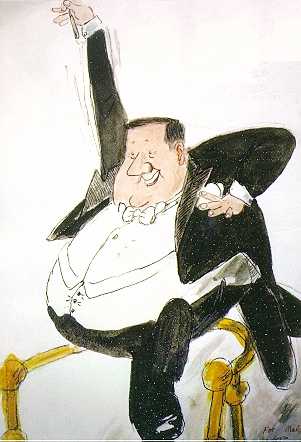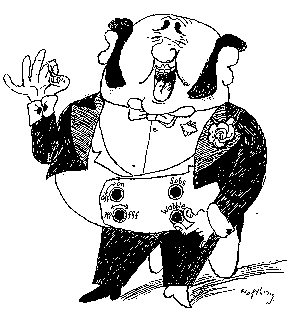All photographs and art work © The Hoffnung Partnership. Please respect this copyright.



Another favourite work is Overture: Leonora No.IV by Beethoven
and arranged for the Hoffnung concerts by Malcolm Arnold. Here we find
off-stage trumpeters positioned in the auditorium in numbers never imagined
in the preceeding three versions of the work. Here, too, Beethoven invents
the waltz and the interaction between conductor and orchestra as well
as the intrusion of a street band leaves much to be desired.
The foregoing gives an inkling of the delights to be experienced at
a Hoffnung concert. Over the intervening years several new works have been
added to the repertoire. Amongst these is Concerto d'Amore for violin
and orchestra, written by Wilfred Josephs. Trouble starts here even before
the performance commences when, due to a booking error, a second violinist
unexpectedly turns up on the platform. In order to avoid serious legal
complications a decision is taken by the orchestral manager, who inists that
both (male and female) soloists play. This unleashes strong emotions of anger,
hate and jealousy which happily are transformed into those of deepest love.
Another unusual and more recent work is Peter Thomas' Composers'
Party, which offers the orchestra a rest from
instrumental playing and an opportunity to display its vocal talents instead.
There is also an arrangement by Maynard Nelson of Giacomo Scarlatina's Act
9 Scene 24 from his opera Quasimodo et Giulietta, which has regularly
taxed tenors, despite their access to mechanical aids.
which offers the orchestra a rest from
instrumental playing and an opportunity to display its vocal talents instead.
There is also an arrangement by Maynard Nelson of Giacomo Scarlatina's Act
9 Scene 24 from his opera Quasimodo et Giulietta, which has regularly
taxed tenors, despite their access to mechanical aids.
In the intervening years performances of Hoffnung concerts have been produced in countries as far afield as Norway, Japan, Israel, the States and Australia. As demands increased, a loyal team of soloists and conductors has been established. Any anticipation of problems with different types of national humour soon proved groundless and the subtleties and humour of the concerts have been as readily enjoyed by cowboys in Montana, sophisticates in Los Angeles and even the very serious Fins. The Japanese are tremendous fans. Certainly musical literacy deepens the understanding and intensifies the pleasure of the listener, but the Hoffnung festivals offer a feast of musical and visual humour that even a first-time attender of a symphonic concert will experience enjoyment.
Another of the many successes since Gerard's death has been the establishing and touring of a major exhibition of his work, in which over 400 cartoons have been mounted, framed and crated to form The Hoffnung Exhibition. Age, background and nationality present no barriers to its viewers' keen appreciation and delight and their expressions of acclaim have been constant. When shown at the Edinburgh Festival the Guardian wrote, "Never before at an Edinburgh exhibition can so many visitors have been heard giving way to uninhibited laughter as the crowds filing through the Hoffnung exhibition." Over the years the collection has been shown throughout England, Scotland and Wales and in both Northern and Southern Ireland. Abroad it travelled to major European cities, also to New York and has recently enjoyed great success on a Japanese tour. The British Council reproduced its own collection of drawings designed as a travelling exhibition which journied the world for seven years, touring India, the Middle East, Australia and parts of North and South America.
 |
 |
 Return to MusicWeb International
Return to MusicWeb International